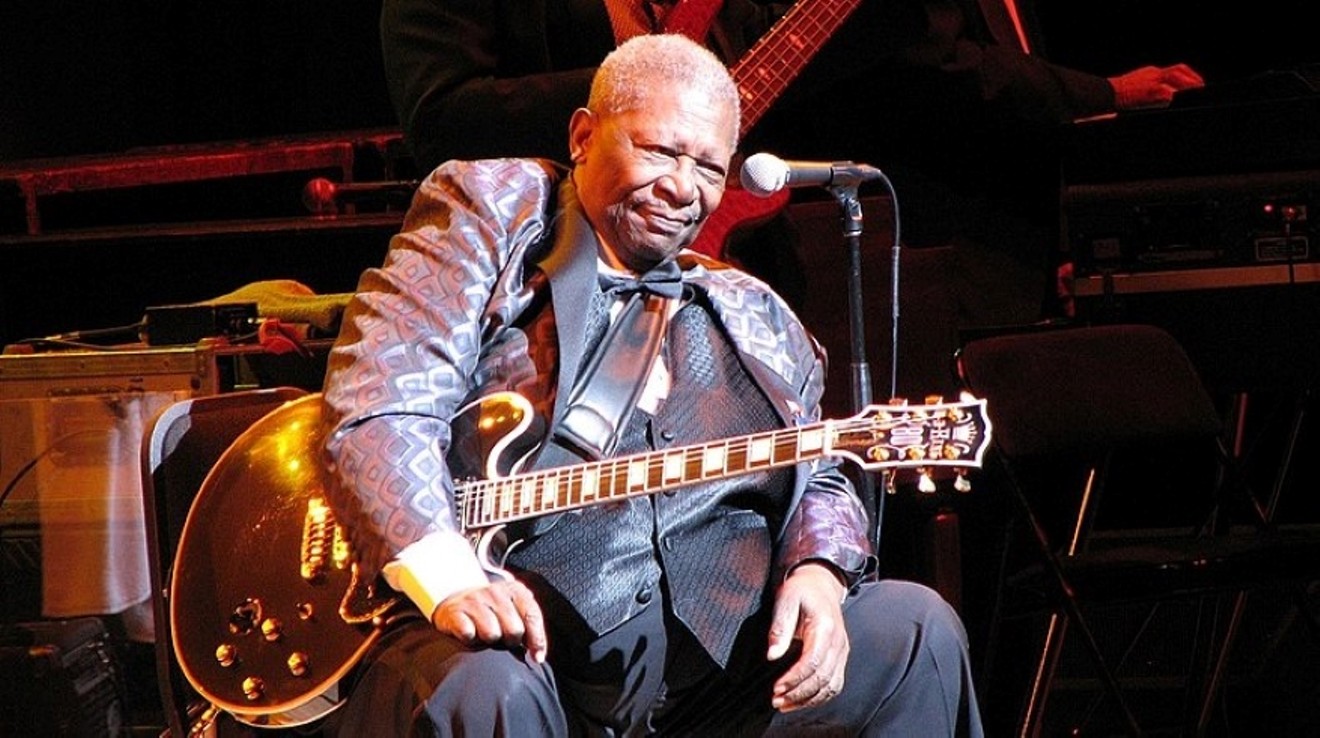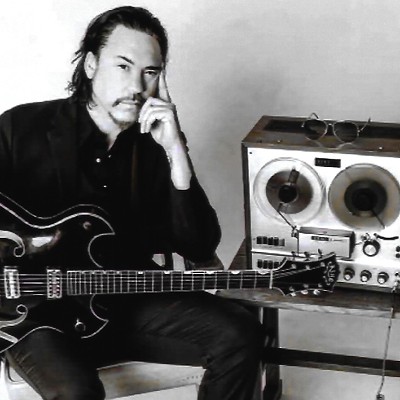But at the center of it all, quite literally, was B.B. ("B." to his friends) King. On that night, King was seated in a chair instead of standing, which was a good idea, as he was nearing his 90th birthday. His body was failing him, and consequently his chops weren't close to what they were when he would hold “chitlin’ circuit” audiences spellbound during his rise to blues royalty.
No matter. The respect and love felt for King was palpable, and he obliged his disciples with occasional hints of the guitar style that informed every blues player who came after him. The word "disciples" is accurate, incidentally, as the assemblage of musicians surrounding King created an unintentional but entirely appropriate resemblance to Leonardo da Vinci's painting The Last Supper.
But it wasn't always like that, as Pulitzer Prize-winning journalist Daniel de Visé explains in his new book, King of the Blues — The Rise and Reign of B.B. King . (Atlantic Monthly Press). The future king of the blues began his musical journey playing a diddley bow, a single-stringed instrument generally found south of the Mason-Dixon line, made from whatever materials one had on hand, e.g. a cigar box, a broom handle, and a piece of wire. By the time it was all over, he held custom-made guitars onstage, emblazoned with "Lucille," the name given to all of his guitars after he rescued a prize instrument from a roadhouse fire, the conflagration resulting from an argument over a woman named “Lucille.” King explained that, by calling his guitars "Lucille," he always had a reminder to never again do anything that stupid.
King's career began in earnest on Beale Street in Memphis, a hotbed of southern music since the days of W.C. Handy. King, whose given name was Riley, was rechristened "B.B." by a radio station manager, and gained recognition as both an air personality and a musician. After a string of hit "race" records, King crossed over to the mainstream in the late '60s with singles like "The Thrill is Gone" and albums like Live at the Regal.
His status as a natural treasure was cemented by the '80s, and his latter days were filled with duet albums and other sorts of collaborations. Though for every gem like Riding with the King, a joint venture with acolyte Eric Clapton, King also loosed upon the world records like “When Love Comes to Town,” a contrived business project that had him fronting Irish humble-braggers U2.
In the first portion of the volume, de Visé alternates accounts of King’s Dickensian childhood in Mississippi and the rise of the blues, concentrating more on the former than the latter. This is a wise decision, as there are plenty of fine books documenting the form’s musical foundations, its history, and its artists. What de Visé provides is insight into King’s character by way of revealing anecdotes from his early years. Among these an account of a gonorrhea treatment that King received from a country doctor, the details of which involve King’s scrotum, a heavy book, and a tree stump.
Which brings up the book’s major revelation, that King did not, as mythology has previously indicated, father 15 children with 15 different women. The trope of the bluesman as a guitar-toting satyr has long fueled the imagination of fans, but according to de Visé, King was not a member of this virile club. Rather, the author contends, King was sterile by the time he reached adulthood, the result of 1) a nasty case of the mumps, 2) a nether-regions injury sustained in a tussle with a ram, and 3) that book and stump thing.
De Visé does an admirable job of exploring the paradox of “crossover.” Realizing that his earnings would be forever limited by playing to an exclusively Black audience, King sought to break through to white listeners, achieving this feat by virtue of his own tenacity and through the support of admirers like promoter Bill Graham, who booked King in his Fillmore East and Fillmore West auditoriums, putting the bluesman in front of young stoners entranced by his artistry. The Rolling Stones also helped out, hiring King to open a series of dates on their groundbreaking 1969 tour, as documented in the Maysles brothers’ film Gimme Shelter.
However much he (and his wallet) desired a larger, more diverse audience, King still felt the need to connect to his own people, perhaps even feeling a measure of guilt for going uptown. De Visé’s introduction to the book examines this conflict by detailing the circumstances surrounding the recording of the 1970 album B.B. King Live in Cook County Jail.
The album title’s preposition is significant. King and his band did not perform at the jail, they performed in the jail, on a raggedy stage set up in a dusty exercise yard. The musicians heard the steel doors clanging shut behind them, endured the grim scrutiny of the prison guards, and ate the same awful food as the prisoners did prior to their performance.
King reveled in his interaction with the convicts, most of them Black and, therefore, knowledgeable in the give and take between artist and audience that is a key component of blues and gospel performances. After the show, King said, “(It) made me sad and glad.”
The B.B. King story does not have a happy ending. For many years, he was the ultimate road dog, sometimes playing over 300 live dates per year. When the serious money started to come in during the late 1990s, King could have cut down on his touring and eased into a life of leisure. For a variety of reasons, which de Visé details in some depth, King remained on the road, even as his physical and mental abilities began to wane. Close friends and confidants broached the subject of retirement, but King became angry at such suggestions.For many years, he was the ultimate road dog, sometimes playing over 300 live dates per year.
tweet this
This led to an unfortunate coda to a brilliant career, an unnecessary tarnishing of an established legend. In his later years, concerts became disorganized affairs, with King giving up on songs after a verse or two and talking at unfortunate length between tunes. Even more regrettable, he was given to inappropriate remarks onstage, making audiences uncomfortable and sometimes insulting his onstage guests. De Visé’s recounting of King’s lecherous behavior toward guitarist Susan Tedeschi in front of her husband, fellow guitarist Derek Trucks, is cringe-inducing but, unfortunately, totally accurate.
Lest one leave with the impression that de Visé has presented a dour, humorless account of his subject’s life, the thoughtful and analytical portions of the narrative are counterbalanced with engaging tales from King’s circuitous route to success. Houston is well-represented, as it became a “second home” to King during the 1950s, when he worked with the infamous Don Robey, the owner of Duke-Peacock Records and the Bronze Peacock nightclub.
Of particular note is the story of a meeting between King and saxophonist Charlie Parker in 1952, when the latter was in Houston as part of a package tour including Dizzy Gillespie, Nat Cole, Stan Kenton, and Sarah Vaughan. Parker told King, “I’m a blues player, B. We’re all blues players. It’s just that we all hear blues in different ways. The day we get away from the blues is the day we stop making sense.”
And what would a music biography be without a few saucy stories? When King appeared at the Atlanta Pop Festival in 1970, his preshow practice ritual was interrupted by a knock at his dressing room door. As de Visé recounts, “’Come in,’ he said, without looking up. When he finally did, he beheld a young naked white woman. ‘I’m your escort for the festival,’ she smiled. B.B. had heard about such rituals at the hippie festivals. She wasn’t there for sex, more as living artwork. B.B. found himself gripped by nerves. This was still the Deep South. Old fears returned. ‘I really don’t know how to act,’ he recalled. ‘Don’t wanna be rude; don’t wanna insult the lady; but I sure do wanna stare.’”








